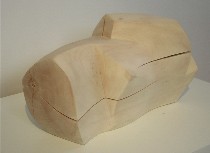
Like the Clay Studio, the Wood Turning Center consistently puts on good shows, brings in non-locals to facilitate the exchange of ideas, and creates a synergy that results in high-quality, original work. These centers also give artists the opportunity to use and experiment with equipment that would exceed what a single artist might afford.
There are a couple of glassblowing studios and photography groups that aim to replicate this kind of cooperation and synergy, but so far, they have not gotten there, but perhaps, given time, they will figure out how to make it happen.
All this is preamble to a report on my visit to the Wood Turning Center’s current show, “allTURNatives: Form + Spirit. ” The work was generated by wood turners from Australia and the United States who were invited for an eight-week residency entitled the International Turning Exchange, during which time they worked and talked and exchanged and synergized.
The work on display includes pieces created during the actual residency as well as some prior work.
Odes on Grecian urns
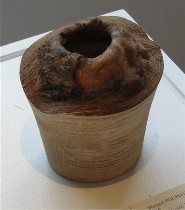 I was surprised by the number of artists who made wooden vessels inspired by traditional clay shapes. These fashioners of vases included a local woodworker Michael Podmaniczky, who described himself in his artist’s statement as just a wood turner, not an artist. Podmaniczky’s “Knot a Vessel” (right) looked like a volcanic cupcake. The horizontal lines of turning on the lathe were a visible statement, the vertical hairline fissures a counterpoint. The merger of the wood’s weirdness with the artist’s intervention is just right.
I was surprised by the number of artists who made wooden vessels inspired by traditional clay shapes. These fashioners of vases included a local woodworker Michael Podmaniczky, who described himself in his artist’s statement as just a wood turner, not an artist. Podmaniczky’s “Knot a Vessel” (right) looked like a volcanic cupcake. The horizontal lines of turning on the lathe were a visible statement, the vertical hairline fissures a counterpoint. The merger of the wood’s weirdness with the artist’s intervention is just right.
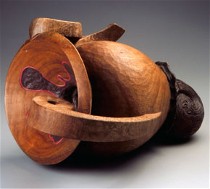 Australia’s protean Marcus Tatton, made a number of vessel-shapes as well, inspired by amphora. Tatton’s “Procreation” (left) was a Greek vase, its base a leafy acanthus-like curlicue inspired by the wood, its top a suggestion of wine “legs” clinging to the lip.
Australia’s protean Marcus Tatton, made a number of vessel-shapes as well, inspired by amphora. Tatton’s “Procreation” (left) was a Greek vase, its base a leafy acanthus-like curlicue inspired by the wood, its top a suggestion of wine “legs” clinging to the lip.
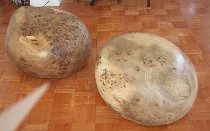 Tatton also was inspired by letters and binary digital symbols, the drawn figures on Greek vases, native art, as well as the wonders of wood and nature (right, “Wood Drops”).
Tatton also was inspired by letters and binary digital symbols, the drawn figures on Greek vases, native art, as well as the wonders of wood and nature (right, “Wood Drops”).
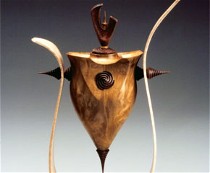 Also inspired by traditional vase forms was American Michael Mocho, whose tiny, tiny vessels displayed his ability to make something surprisingly precious out of a material that seems like it might not permit such control.
Also inspired by traditional vase forms was American Michael Mocho, whose tiny, tiny vessels displayed his ability to make something surprisingly precious out of a material that seems like it might not permit such control.
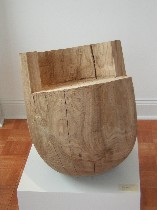
Body art
American Joel Urruty, on the other hand, was inspired by bodies. His “Waitress” (image top of post) made its point with humor, the whorl of the wood providing a natural nipple to the half-a-torso. Even his “Rocker,” (right) evoked body parts.
 And Andrew Potocnik, an Australian, who collaborated some with Urruty at ITE in addition to producing his own work, also was inspired by bodies. “Defense Shield 53 (My Hiding Place)” was a beautiful torso shell of wood, hollowed out behind (left). Potocnik’s work ranged in a number of other directions as well, some highly polished and formal, some with a sense of humor.
And Andrew Potocnik, an Australian, who collaborated some with Urruty at ITE in addition to producing his own work, also was inspired by bodies. “Defense Shield 53 (My Hiding Place)” was a beautiful torso shell of wood, hollowed out behind (left). Potocnik’s work ranged in a number of other directions as well, some highly polished and formal, some with a sense of humor.
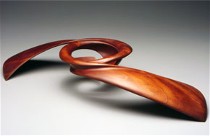
Matthew Harding, an Australian, created meticulous, formal pieces with elegant, smoothly crafted shapes, some of them so finely balanced that they startled with their ability to stand.
The show also included documentary photographs of the woodworkers in action, taken by Linette Messina. I always like to know what artists look like, so these images made me quite happy.
This show will be up until Oct. 23, and it’s well worth your while to find your way to 5th and Vine.









